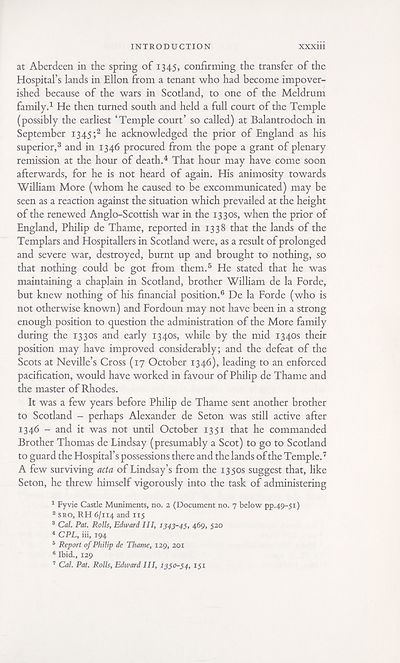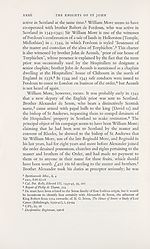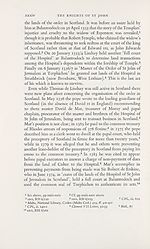Series 4 > Knights of St John of Jerusalem in Scotland
(38) Page xxxiii
Download files
Complete book:
Individual page:
Thumbnail gallery: Grid view | List view

INTRODUCTION xxxiii
at Aberdeen in the spring of 1345, confirming the transfer of the
Hospital’s lands in Ellon from a tenant who had become impover¬
ished because of the wars in Scotland, to one of the Meldrum
family.1 He then turned south and held a full court of the Temple
(possibly the earliest ‘Temple court’ so called) at Balantrodoch in
September 1345;2 he acknowledged the prior of England as his
superior,3 and in 1346 procured from the pope a grant of plenary
remission at the hour of death.4 That hour may have come soon
afterwards, for he is not heard of again. His animosity towards
William More (whom he caused to be excommunicated) may be
seen as a reaction against the situation which prevailed at the height
of the renewed Anglo-Scottish war in the 1330s, when the prior of
England, Philip de Thame, reported in 1338 that the lands of the
Templars and Hospitallers in Scotland were, as a result of prolonged
and severe war, destroyed, burnt up and brought to nothing, so
that nothing could be got from them.5 He stated that he was
maintaining a chaplain in Scotland, brother William de la Forde,
but knew nothing of his financial position.6 De la Forde (who is
not otherwise known) and Fordoun may not have been in a strong
enough position to question the administration of the More family
during the 1330s and early 1340s, while by the mid 1340s their
position may have improved considerably; and the defeat of the
Scots at Neville’s Cross (17 October 1346), leading to an enforced
pacification, would have worked in favour of Philip de Thame and
the master of Rhodes.
It was a few years before Philip de Thame sent another brother
to Scotland - perhaps Alexander de Seton was still active after
1346 - and it was not until October 1351 that he commanded
Brother Thomas de Lindsay (presumably a Scot) to go to Scotland
to guard the Hospital’s possessions there and the lands of the Temple.7
A few surviving acta of Lindsay’s from the 1350s suggest that, like
Seton, he threw himself vigorously into the task of administering
1 Fyvie Castle Muniments, no. 2 (Document no. 7 below pp.49-51)
2 sro, RH 6/114 and H5
3 Cal. Pat. Rolls, Edward III, 1343-45, 469, 520
4 CPL, iii, 194
6 Report of Philip de Thame, 129, 201
6 Ibid., 129
7 Cal. Pat. Rolls, Edward III, 1350-54, 151
at Aberdeen in the spring of 1345, confirming the transfer of the
Hospital’s lands in Ellon from a tenant who had become impover¬
ished because of the wars in Scotland, to one of the Meldrum
family.1 He then turned south and held a full court of the Temple
(possibly the earliest ‘Temple court’ so called) at Balantrodoch in
September 1345;2 he acknowledged the prior of England as his
superior,3 and in 1346 procured from the pope a grant of plenary
remission at the hour of death.4 That hour may have come soon
afterwards, for he is not heard of again. His animosity towards
William More (whom he caused to be excommunicated) may be
seen as a reaction against the situation which prevailed at the height
of the renewed Anglo-Scottish war in the 1330s, when the prior of
England, Philip de Thame, reported in 1338 that the lands of the
Templars and Hospitallers in Scotland were, as a result of prolonged
and severe war, destroyed, burnt up and brought to nothing, so
that nothing could be got from them.5 He stated that he was
maintaining a chaplain in Scotland, brother William de la Forde,
but knew nothing of his financial position.6 De la Forde (who is
not otherwise known) and Fordoun may not have been in a strong
enough position to question the administration of the More family
during the 1330s and early 1340s, while by the mid 1340s their
position may have improved considerably; and the defeat of the
Scots at Neville’s Cross (17 October 1346), leading to an enforced
pacification, would have worked in favour of Philip de Thame and
the master of Rhodes.
It was a few years before Philip de Thame sent another brother
to Scotland - perhaps Alexander de Seton was still active after
1346 - and it was not until October 1351 that he commanded
Brother Thomas de Lindsay (presumably a Scot) to go to Scotland
to guard the Hospital’s possessions there and the lands of the Temple.7
A few surviving acta of Lindsay’s from the 1350s suggest that, like
Seton, he threw himself vigorously into the task of administering
1 Fyvie Castle Muniments, no. 2 (Document no. 7 below pp.49-51)
2 sro, RH 6/114 and H5
3 Cal. Pat. Rolls, Edward III, 1343-45, 469, 520
4 CPL, iii, 194
6 Report of Philip de Thame, 129, 201
6 Ibid., 129
7 Cal. Pat. Rolls, Edward III, 1350-54, 151
Set display mode to:
![]() Universal Viewer |
Universal Viewer | ![]() Mirador |
Large image | Transcription
Mirador |
Large image | Transcription
Images and transcriptions on this page, including medium image downloads, may be used under the Creative Commons Attribution 4.0 International Licence unless otherwise stated. ![]()
| Scottish History Society volumes > Series 4 > Knights of St John of Jerusalem in Scotland > (38) Page xxxiii |
|---|
| Permanent URL | https://digital.nls.uk/126637971 |
|---|
| Description | Over 180 volumes, published by the Scottish History Society, containing original sources on Scotland's history and people. With a wide range of subjects, the books collectively cover all periods from the 12th to 20th centuries, and reflect changing trends in Scottish history. Sources are accompanied by scholarly interpretation, references and bibliographies. Volumes are usually published annually, and more digitised volumes will be added as they become available. |
|---|


